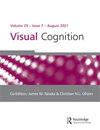How scene encoding affects memory discrimination: Analysing eye movements data using data driven methods
IF 1.4
4区 心理学
Q3 PSYCHOLOGY, EXPERIMENTAL
引用次数: 0
Abstract
ABSTRACT Encoding of visual scenes remains under-explored due to methodological limitations. In this study, we evaluated the relationship between memory accuracy for visual scenes and eye movements at encoding. First, we used data-driven methods, a fixation density map (using iMap4) and a saliency map (using GBVS), to analyse the visual attention for items. Second, and in a more novel way, we conducted scanpath analyses without a priori (using ScanMatch). Scene memory accuracy was assessed by asking participants to discriminate identical scenes (targets) among rearranged scenes sharing some items with targets (distractors) and new scenes. Shorter fixation duration in regions of interest (ROIs) at encoding was associated with a better rejection of distractors; there was no significant difference in the relative fixation time in ROIs at encoding, between subsequent hits and misses at test. Hence, density of eye fixations in data-driven ROIs seems to be a marker of subsequent memory discrimination and pattern separation. Interestingly, we also identified a negative correlation between average MultiDimensional Scaling (MDS) distance scanpaths and the correct rejection of distractors, indicating that scanpath consistency significantly affects the ability to discriminate distractors from targets. These data suggest that visual exploration at encoding participates in discrimination processes at test.场景编码如何影响记忆辨别:使用数据驱动方法分析眼动数据
摘要由于方法的限制,视觉场景的编码仍然没有得到充分的探索。在这项研究中,我们评估了视觉场景的记忆准确性与编码时眼球运动之间的关系。首先,我们使用数据驱动的方法,即固定密度图(使用iMap4)和显著性图(使用GBVS),来分析项目的视觉注意力。其次,以一种更新颖的方式,我们在没有先验的情况下进行了扫描路径分析(使用ScanMatch)。通过让参与者在与目标(干扰物)和新场景共享一些项目的重新排列的场景中区分相同的场景(目标)来评估场景记忆的准确性。编码时感兴趣区域(ROI)的注视持续时间越短,干扰物的排斥反应越好;在编码时ROI的相对注视时间、随后的命中和测试中的未命中之间没有显著差异。因此,数据驱动的ROI中眼睛注视的密度似乎是随后记忆辨别和模式分离的标志。有趣的是,我们还发现平均多维尺度(MDS)距离扫描路径与干扰物的正确排斥之间存在负相关,表明扫描路径的一致性显著影响区分干扰物和目标的能力。这些数据表明,编码时的视觉探索参与了测试中的辨别过程。
本文章由计算机程序翻译,如有差异,请以英文原文为准。
求助全文
约1分钟内获得全文
求助全文
来源期刊

VISUAL COGNITION
PSYCHOLOGY, EXPERIMENTAL-
CiteScore
4.20
自引率
10.00%
发文量
29
期刊介绍:
Visual Cognition publishes new empirical research that increases theoretical understanding of human visual cognition. Studies may be concerned with any aspect of visual cognition such as object, face, and scene recognition; visual attention and search; short-term and long-term visual memory; visual word recognition and reading; eye movement control and active vision; and visual imagery. The journal is devoted to research at the interface of visual perception and cognition and does not typically publish papers in areas of perception or psychophysics that are covered by the many publication outlets for those topics.
 求助内容:
求助内容: 应助结果提醒方式:
应助结果提醒方式:


